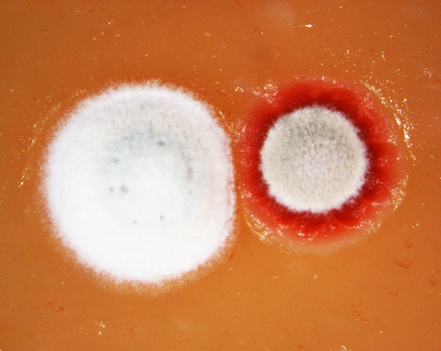

instituto de biologia molecular e celular | institute for molecular and cell biology
Previous Research Results
Our group has been addressing the molecular mechanisms underlying the stress response, namely oxidative stress in yeast and bacteria. At present the work focuses on the effect of reactive oxygen species (ROS), such as hydrogen peroxide, in the production of secondary metabolites in Streptomyces.
Streptomyces are Gram-positive, filamentous, soil-dwelling bacteria well known for their ability to produce a wide variety of secondary metabolites such as antibiotics and immuno-suppressant agents, among others. Streptomyces secondary metabolism is regulated by a complex network involving multiple factors and taking place at different levels: from pathway-specific regulatory genes to pleiotropic regulators which control both secondary metabolism and morphological differentiation
The work aims at identifying the molecular mechanism(s) induced by hydrogen peroxide that can play a role in the regulatory network governing the synthesis of secondary metabolites. Recently we were able to construct Streptomyces knock-out mutants on H2O2-related anti-oxidative enzymes that allowed us to modulate the intracellular redox status. In doing so, we have highlighted the crosstalk between intracellular ROS homeostasis and secondary metabolism in Streptomyces.

IMAGE: Streptomyces coelicolor colony (ies).
Future Research
We will continue studying the bacterial signaling networks and the molecular interactions between them. We will focus on the molecular basis of the redox-dependent regulation of secondary metabolism in Streptomyces.
In the short-term two main questions will be addressed: (i) what are the molecular mechanisms behind the crosstalk between ROS homeostasis signalling pathways and secondary metabolism in Streptomyces spp. and (ii) can ROS homeostasis modulation be used to obtain improved fermentation yields.
In the long term we will seek to expand the research to other physiological processes and how they integrate into the binomial redox signaling / secondary metabolism. The first process that we intend to focus is quorum-sensing, a phenomenon directly related to secondary metabolism in Streptomyces. For that purpose a new project that integrates phylogenomics and physiological approaches on the study of quorum-sensing in the actinobacteria phylum is already in place.
Selected References:
Bunet, R., L. Song, M. V. Mendes, C. Corre, L. Hotel, N. Rouhier, X. Framboisier, P. Leblond, G. L. Challis & B. Aigle, (2011) Characterization and manipulation of the pathway-specific late regulator AlpW reveals Streptomyces ambofaciens as a new producer of Kinamycins. J Bacteriol 193: 1142-1153.
Santos CL, Tavares F, Thioulouse J & Normand P. (2009) A phylogenomic analysis of bacterial helix-turn-helix transcription factors. FEMS Microbiol Rev. 33: 411-29.
Santos CL, Vieira J, Tavares F, Benson DR, Tisa LS, Berry AM, Moradas-Ferreira P & Normand P. (2008) . On the nature of fur evolution: a phylogenetic approach in Actinobacteria. BMC Evol Biol.: 8: 185
Costa V, Quintanilha A & Moradas-Ferreira P. (2007) Protein oxidation, repair mechanisms and proteolysis in Saccharomyces cerevisiae. IUBMB Life. 59: 293-8.
Mendes, M. V., E. Recio, N. Anton, S. M. Guerra, J. Santos-Aberturas, J. F. Martin & J. F. Aparicio, (2007) Cholesterol oxidases act as signaling proteins for the biosynthesis of the polyene macrolide pimaricin. Chem Biol 14: 279-290.
Mendes, M. V., S. Tunca, N. Anton, E. Recio, A. Sola-Landa, J. F. Aparicio & J. F. Martin, (2007) The two-component phoR-phoP system of Streptomyces natalensis: Inactivation or deletion of phoP reduces the negative phosphate regulation of pimaricin biosynthesis. Metab Eng 9: 217-227.

Mendes, Marta
mvm@ibmc.up.pt
Barbosa de Oliveira, Rute
rute.oliveira@i3s.up.pt
Pinho, Maria Helena
maria.pinho@ibmc.up.pt
Home | Site Map | Contacts | Credits | Privacy & Cookies | WHISTLEBLOWER CHANNEL | Intranet | Social Networks |
